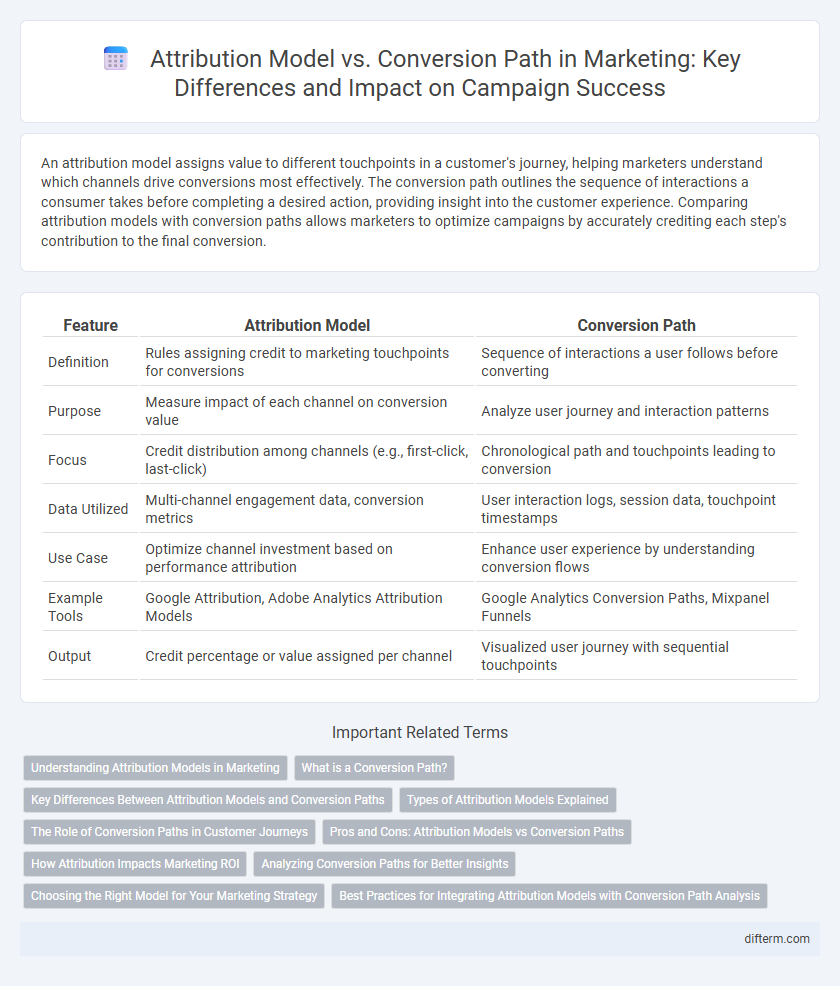An attribution model assigns value to different touchpoints in a customer's journey, helping marketers understand which channels drive conversions most effectively. The conversion path outlines the sequence of interactions a consumer takes before completing a desired action, providing insight into the customer experience. Comparing attribution models with conversion paths allows marketers to optimize campaigns by accurately crediting each step's contribution to the final conversion.
Table of Comparison
| Feature | Attribution Model | Conversion Path |
|---|---|---|
| Definition | Rules assigning credit to marketing touchpoints for conversions | Sequence of interactions a user follows before converting |
| Purpose | Measure impact of each channel on conversion value | Analyze user journey and interaction patterns |
| Focus | Credit distribution among channels (e.g., first-click, last-click) | Chronological path and touchpoints leading to conversion |
| Data Utilized | Multi-channel engagement data, conversion metrics | User interaction logs, session data, touchpoint timestamps |
| Use Case | Optimize channel investment based on performance attribution | Enhance user experience by understanding conversion flows |
| Example Tools | Google Attribution, Adobe Analytics Attribution Models | Google Analytics Conversion Paths, Mixpanel Funnels |
| Output | Credit percentage or value assigned per channel | Visualized user journey with sequential touchpoints |
Understanding Attribution Models in Marketing
Attribution models in marketing define how credit for sales and conversions is assigned to various touchpoints in the customer journey, enabling businesses to analyze the effectiveness of different marketing channels. Understanding these models, such as last-click, first-click, linear, time decay, and position-based, helps marketers allocate budgets strategically and optimize campaigns for higher ROI. Conversion paths illustrate the sequence of interactions leading to a conversion, and evaluating them alongside attribution models provides deeper insights into customer behavior and channel performance.
What is a Conversion Path?
A conversion path represents the sequence of interactions a user takes before completing a desired action, such as making a purchase or filling out a form. It includes touchpoints across multiple channels like social media, email, paid ads, and organic search that influence the customer journey. Understanding conversion paths helps marketers optimize campaign strategies by identifying critical points where users engage most effectively.
Key Differences Between Attribution Models and Conversion Paths
Attribution models allocate credit to various marketing touchpoints based on specific rules, such as last-click or linear distribution, identifying which channels contribute most to conversions. Conversion paths represent the actual sequences of interactions a customer experiences before completing a desired action, detailing the flow across multiple channels and devices. The key difference lies in attribution models providing a structured framework to assign value among touchpoints, while conversion paths offer a visual and analytical narrative of the customer's journey.
Types of Attribution Models Explained
Attribution models in marketing determine how credit for conversions is assigned across different touchpoints in a customer's journey. Common types include last-click, which attributes all credit to the final interaction; first-click, giving full credit to the initial touchpoint; linear, distributing equal credit among all interactions; time-decay, prioritizing recent engagements; and position-based, allocating credit primarily to the first and last touchpoints. Understanding these models helps marketers optimize budget allocation by accurately evaluating the influence of various channels in the conversion path.
The Role of Conversion Paths in Customer Journeys
Conversion paths play a crucial role in mapping customer journeys by tracing the sequence of touchpoints that lead to a conversion, offering insights into how different channels contribute to buyer decisions. Unlike attribution models that assign specific credit values to each interaction, conversion paths provide a holistic view of the user experience across multiple sessions and platforms. Understanding conversion paths enables marketers to optimize campaign strategies and allocate budgets more effectively by identifying the most influential customer touchpoints.
Pros and Cons: Attribution Models vs Conversion Paths
Attribution models provide a structured way to assign credit to various marketing touchpoints, offering clear insights into which channels drive conversions but can oversimplify complex customer journeys. Conversion paths capture the full sequence of user interactions before a purchase, delivering a comprehensive view of consumer behavior but often complicating data analysis due to their length and variability. Businesses must balance the precision of attribution models with the holistic perspective of conversion paths to optimize marketing strategies effectively.
How Attribution Impacts Marketing ROI
Attribution models assign credit to various marketing touchpoints, directly influencing how budget allocations maximize Marketing ROI. Understanding the entire conversion path reveals which channels effectively drive sales, enabling marketers to optimize campaigns and reduce wasted spend. Accurate attribution translates to improved decision-making, higher return on ad spend (ROAS), and more precise marketing investment strategies.
Analyzing Conversion Paths for Better Insights
Analyzing conversion paths reveals the sequence of interactions consumers have before completing a purchase, providing granular insights into touchpoints that influence conversions. Attribution models allocate credit to these touchpoints based on predefined rules or data-driven methods, helping marketers understand the relative impact of each channel. Combining detailed conversion path analysis with appropriate attribution models enables more accurate measurement of marketing effectiveness and optimization of budget allocation.
Choosing the Right Model for Your Marketing Strategy
Selecting the appropriate attribution model is essential for accurately evaluating marketing performance and optimizing budget allocation. Understanding the full conversion path reveals customer touchpoints and helps identify which channels contribute most effectively to conversions. Balancing insights from both multi-touch attribution and the specific stages of the customer journey improves strategic decision-making and drives higher ROI.
Best Practices for Integrating Attribution Models with Conversion Path Analysis
Integrating attribution models with conversion path analysis requires aligning multi-touch attribution models such as linear, time-decay, or algorithmic with detailed user journey data to accurately assign credit across marketing channels. Leveraging tools like Google Analytics 4 or Adobe Analytics enables marketers to track and visualize touchpoints, refining attribution by incorporating dwell time, interaction frequency, and conversion velocity metrics. Prioritize continuous data validation and model testing to adapt attribution frameworks dynamically, ensuring that insights reflect evolving consumer behaviors and optimize marketing spend effectively.
Attribution model vs conversion path Infographic

 difterm.com
difterm.com